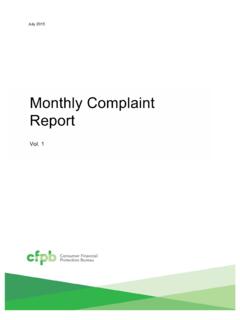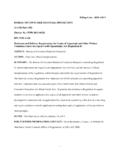Transcription of Suspicious Activity Reports on Elder Financial ...
1 CONSUMER Financial PROTECTION BUREAU | FEBRUARY 2019. Suspicious Activity Reports on Elder Financial Exploitation: Issues and Trends Office of Financial Protection for Older Americans Table of contents Executive Summary .. 3. Key findings .. 3. 1. Introduction .. 6. 2. Background .. 8. 3. Trends in SAR submissions .. 11. SAR filings on Elder Financial exploitation quadrupled from 2013 to 2017 .. 11. Money services businesses have filed an increasing share of EFE SARs .. 12. 4. Monetary losses reported in EFE SARs .. 14. Filers reported a total of $ billion in Suspicious activities in 2017 .. 14. Nearly 80 percent of EFE SARs involved a monetary loss .. 15. Older adults' monetary losses were more common and greater than filers'. losses .. 15. One third of the individuals who lost money were ages 80 and older.
2 16. Adults ages 70 to 79 had the highest average monetary loss .. 17. Monetary losses were greater when the older adult knew the suspect .. 17. 5. Patterns in EFE SARs .. 19. Types of Suspicious Activity varied significantly by filer .. 19. More than half of EFE SARs involved a money transfer .. 21. Checking or savings accounts had the highest monetary losses .. 22. The Suspicious Activity reported in a SAR took place, on average, over a four-month period .. 22. Fewer than one-third of EFE SARs indicated that the filer reported the Suspicious Activity to a local, state or federal authority .. 23. 6. Implications and Next Steps .. 25. 1 CONSUMER Financial PROTECTION BUREAU. APPENDIX A: METHODOLOGY .. 28. APPENDIX B: DETAILED TABLES .. 31. APPENDIX C: BURE AU INITI ATIVES TO HELP FINANCI AL.
3 INSTITUTIONS FIGHT Elder FINANCI AL EXPLOITATION .. 34. APPENDIX D: GLOSS ARY .. 35. 2 CONSUMER Financial PROTECTION BUREAU. Executive Summary Since 2013, Financial institutions have reported to the federal government over 180,000. Suspicious activities targeting older adults, involving a total of more than $6 billion. These Reports indicate that Financial exploitation of older adults by scammers, family members, caregivers, and others is widespread in the United States. The Reports also provide unique data on these Suspicious activities, which can enhance ongoing efforts to prevent Elder Financial exploitation and to punish wrongdoers. This study analyzes a rich, non-public data set to shed light on the volume and characteristics of Elder Financial exploitation (EFE). The study explores the Suspicious Activity Reports (SARs).
4 Filed with the federal government by Financial institutions such as banks and money services businesses. This is the first public analysis of EFE SAR filings since the Financial Crimes Enforcement Network (FinCEN), which receives and maintains the database of SARs, introduced electronic SAR filing with a designated category for Elder Financial exploitation in 2013. This report presents findings based on selected data fields from all EFE SARs filed between 2013. and 2017. The report also presents findings based on a representative sample of SAR transcripts, which include a narrative portion supplied by the Financial institution. The findings provide an opportunity to better understand the complex problem of Elder Financial exploitation and to identify ways to improve prevention and response.
5 Key findings SAR filings on Elder Financial exploitation quadrupled from 2013 to 2017. In 2017, Elder Financial exploitation (EFE) SARs totaled 63,500. Based on recent prevalence studies, these 2017 SARs likely represent a tiny fraction of actual incidents of Elder Financial exploitation. Money services businesses have filed an increasing share of EFE SARs. In 2016, money services business (MSB) filings surpassed depository institution (DI). filings. In 2017, MSB SARs comprised 58 percent of EFE SARs, compared to 15 percent in 2013. Financial institutions reported a total of $ billion in Suspicious activities in 2017, including actual losses and attempts to steal the older adults' funds. 3 CONSUMER Financial PROTECTION BUREAU. Nearly 80 percent of EFE SARs involved a monetary loss to older adults and/or filers ( Financial institutions).
6 In EFE SARs involving a loss to an older adult, the average amount lost was $34,200. In 7 percent of these EFE SARs, the loss exceeded $100,000. When a filer lost money, the average loss per filer was $16,700. One third of the individuals who lost money were ages 80 and older. Adults ages 70 to 79 had the highest average monetary loss ($45,300). Losses were greater when the older adult knew the suspect. The average loss per person was about $50,000 when the older adult knew the suspect and $17,000 when the suspect was a stranger. Types of Suspicious Activity varied significantly by filer. When the filer was an MSB, 69 percent of EFE SARs described scams by strangers. DI filings, in contrast, involved an array of Financial crimes, with 27 percent involving stranger scams. More than half of EFE SARs involved a money transfer.
7 The second-most common Financial product used to move funds was a checking or savings account (44. percent). Checking or savings accounts had the highest monetary losses. The average monetary loss to the older adult was $48,300 for EFE SARs involving a checking or savings account while the average loss was $32,800 for EFE SARs involving a money transfer. The Suspicious Activity reported in an EFE SAR took place, on average, over a four-month period. Fewer than one-third of EFE SARs indicated that the filer reported the Suspicious Activity to a local, state, or federal authority. Only one percent of MSB SARs stated that the MSB reported the Suspicious Activity in the SAR to a government entity such as adult protective services or law enforcement. Implications for key stakeholders SARs indicate that Elder Financial exploitation is widespread and damaging.
8 This analysis of EFE SARs highlights the need for strong and diverse interventions by Financial institutions, law enforcement, and social services, as well as the involvement of policymakers. 4 CONSUMER Financial PROTECTION BUREAU. Financial institutions are filing an increasing number of EFE SARs, but in most cases the SARs do not indicate that Financial institutions are reporting Elder Financial exploitation to law enforcement or adult protective services. This is a missed opportunity to increase investigation and prosecution, and to make it more likely that victims will receive appropriate services. EFE SARs are a useful and untapped resource for monitoring and measuring Elder Financial exploitation. Regularly studying the trends, patterns and issues in EFE SARs can help stakeholders enhance protections through independent and collaborative work.
9 The types of suspects and activities reported by money services businesses and depository institutions differ significantly, and interventions can be tailored accordingly. Key stakeholders and policymakers can read the findings and develop new responses. This report suggests distinct strategies that MSBs and DIs can implement. Law enforcement can mine the growing database of EFE SARs to be more proactive in investigating cases and bringing more prosecutions. This use of SARs by law enforcement can trigger new investigations, enhance ongoing inquiries, and increase prosecutions. 5 CONSUMER Financial PROTECTION BUREAU. 1. Introduction Since 2013, Financial institutions have reported to the federal government over 180,000. Suspicious activities targeting older adults, involving more than $6 billion.
10 These Reports indicate that Financial exploitation of older adults by scammers, family members, caregivers, and others is widespread in the United States. The Reports also provide unique data on these Suspicious activities, which can enhance ongoing efforts to prevent Elder Financial exploitation and to punish wrongdoers. This study analyzes a rich, non-public data set to shed light on the volume and characteristics of Elder Financial exploitation (EFE). The study explores the Suspicious Activity Reports (SARs). filed with the federal government by Financial institutions such as banks and money services businesses. This is the first public analysis of EFE SAR filings since the Financial Crimes Enforcement Network (FinCEN), which receives and maintains the database of SARs, introduced electronic SAR filing with a designated category for Elder Financial exploitation in 2013.














